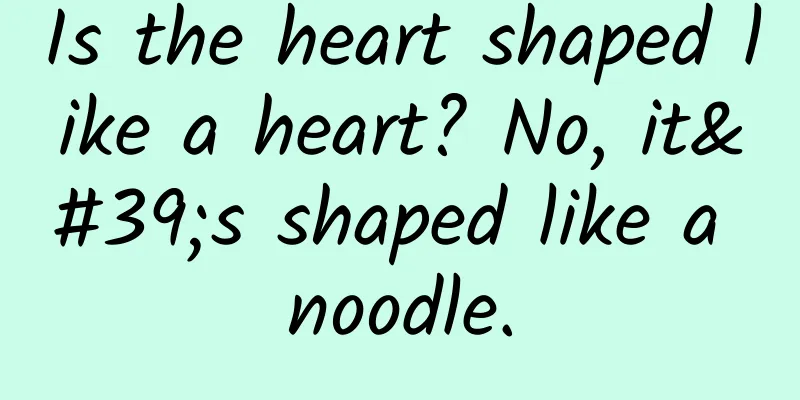Is the heart shaped like a heart? No, it's shaped like a noodle.

|
The heart shape has always been a symbol of love and romance in the hearts of people all over the world. But did you know that the heart shape has nothing to do with the shape of the heart? So what is the shape of a real heart? Well, it's probably like loincloth noodles. What?! The heart is a wide noodle?! That’s right, the heart is not what most of us think, a whole composed of four independent chambers of two atria and two ventricles. It is more like an object rolled up by a long wide noodle. This shape is the Möbius strip, also called the Möbius ring . Here it is, a classic exhibit at the China Science and Technology Museum. The Möbius strip was discovered by German mathematicians Mobius and Johann Listing in 1858. This structure is very simple, it is a paper strip twisted 180 degrees, and then glued together at both ends to make a paper strip loop. Ordinary paper strips have two sides, while the Möbius strip has only one side. If a small ant keeps crawling along the center line of the paper strip, it can pass through the entire curved surface without crossing the edge of the paper strip. The Möbius strip is a very beautiful mathematical structure that has many applications in life. For example, if a mechanical conveyor belt is made into this shape, it can be worn evenly instead of always wearing on one side. So how does the heart roll up? First of all, we must correct that the correct name for the "wide face" should be the " myocardial band ". This myocardial band does not twist once, but twists three times to form a cone-like shape that is small at the bottom and large at the top. Scientists have only discovered the secrets of the heart in the past few decades. As early as the 16th century, people discovered that the heart has a cone shape. But why does the heart beat? The relationship between heart shape and function has remained a mystery for the next 500 years. This problem has also been called the Gordian knot of anatomy, which is described as a problem that is harder than climbing to the sky. In the 17th century, English physician William Harvey discovered the circulatory system and connected the heart and lungs into a closed loop of the entire circulatory system. He believed that the human heart is a homogeneous muscle with four chambers that expels blood when the myocardium contracts and fills with blood when it relaxes. Although Harvey is regarded as the father of the circulatory system and his doctrine has been written into textbooks for generations, his theory still has some contradictions. It was not until about 50 years ago that Spanish doctor Torrent-Guasp finally solved this "heart knot" that was as difficult as climbing to the sky. He found that the heart is like a wide strip of tendons, which is composed of some spiral shapes. This wide strip is the myocardial band. The spiral structure of the myocardial band is found in the hearts of mammals and birds, and the spiral itself is also very common in nature. Shells, pine cones, and sunflowers all contain spirals. This spiral is very similar to the "twisting towel" we use in daily life. The beating of the heart actually achieves contraction and relaxation in the way of " twisting the towel ". Doctor Torrent-Guasp As for why our hearts are like this, Torrent-Guasp also gave a hypothesis, believing that the original version of the human heart was a worm 1 billion years ago. It had no ventricles and atria, and could only make body fluids flow throughout the body by peristalsis; 400 million years ago, the "little worm" that evolved into a fish finally had a version 1.0 heart. This ancient heart had a ventricle for pumping blood; 200 million years ago, the heart system of fish was upgraded to version 2.0, and when it evolved into the heart of reptiles, ventricles and atria appeared; later, the more complex heart of mammals appeared. What's more interesting is that in the first few dozen days of human embryonic development, the heart evolves from insects to fish, reptiles, and mammals. It seems that our wonderful bodies are the essence of many years of biological evolution. Of course, Rong Ge must make it clear that this view is only a hypothesis at present and needs more research to support it. From left to right: Comparison of the hearts of fish (carp), amphibian (frog), reptile (snake), bird (pigeon), and mammal (rabbit). But no matter what, the heart is one of the most sophisticated organs in the human body, and it has a lot of secrets that need to be studied and is worth studying. Maybe one day we can create a new device based on the principle of the heart and completely change our lives. |
>>: The 8 major "culprits" that damage the kidneys in summer, how many of them are you guilty of?
Recommend
Is it useful to take birth control pills 24 hours after sex?
In the case of unplanned intercourse, oral contra...
Keep warm together? Blood routine test found "jelly blood", it turns out that red blood cells are also "afraid of cold"
After the Spring Festival, the cold wind blew in ...
What is the reason for a woman's big belly?
It is normal for a married man to have a big bell...
How to make menstrual detoxification cleaner
Many people may not know that women's lifespa...
What to do if you are allergic to vulvar medication
Some women will go to the hospital to buy vulva c...
Will a false pregnancy show positive?
False pregnancy mainly refers to the appearance o...
What happens if you eat too much Moringa seeds? Will eating too much Moringa seeds cause poisoning?
Moringa seeds contain high protein and fiber. Reg...
How many days does it actually take from pregnancy to birth?
As the saying goes, "Ten months of pregnancy...
Can I eat comfrey during menstruation?
Many female friends have no problems normally, bu...
Why does the sour smell of vaginal discharge
Every woman needs to pay attention to the state o...
Gum swelling and pain during confinement
The confinement period is the golden time for the...
Will my breasts swell and hurt when I'm pregnant?
In the early stages of pregnancy, because many ho...
What is vaginal inflammation and swelling?
Vaginal inflammation and redness and swelling are...
Is uterine maintenance really useful?
Nowadays, with the ever-accelerating pace of life...
Do you need an IV drip every time you get sick? These diseases don't require it.
All along In everyone’s perception Compared with ...









